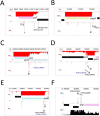A comparison of key aspects of gene regulation in Streptomyces coelicolor and Escherichia coli using nucleotide-resolution transcription maps produced in parallel by global and differential RNA sequencing
- PMID: 25266672
- PMCID: PMC4681348
- DOI: 10.1111/mmi.12810
A comparison of key aspects of gene regulation in Streptomyces coelicolor and Escherichia coli using nucleotide-resolution transcription maps produced in parallel by global and differential RNA sequencing
Abstract
Streptomyces coelicolor is a model for studying bacteria renowned as the foremost source of natural products used clinically. Post-genomic studies have revealed complex patterns of gene expression and links to growth, morphological development and individual genes. However, the underlying regulation remains largely obscure, but undoubtedly involves steps after transcription initiation. Here we identify sites involved in RNA processing and degradation as well as transcription within a nucleotide-resolution map of the transcriptional landscape. This was achieved by combining RNA-sequencing approaches suited to the analysis of GC-rich organisms. Escherichia coli was analysed in parallel to validate the methodology and allow comparison. Previously, sites of RNA processing and degradation had not been mapped on a transcriptome-wide scale for E. coli. Through examples, we show the value of our approach and data sets. This includes the identification of new layers of transcriptional complexity associated with several key regulators of secondary metabolism and morphological development in S. coelicolor and the identification of host-encoded leaderless mRNA and rRNA processing associated with the generation of specialized ribosomes in E. coli. New regulatory small RNAs were identified for both organisms. Overall the results illustrate the diversity in mechanisms used by different bacterial groups to facilitate and regulate gene expression.
© 2014 The Authors. Molecular Microbiology published by John Wiley & Sons Ltd.
Figures










References
-
- Argaman L, Hershberg R, Vogel J, Bejerano G, Wagner EGH, Margalit H, Altuvia S. Novel small RNA-encoding genes in the intergenic regions of Escherichia coli. Curr Biol. 2001;11:941–950. - PubMed
Associated data
- Actions
- Actions
Grants and funding
LinkOut - more resources
Full Text Sources
Other Literature Sources
Molecular Biology Databases
Miscellaneous

